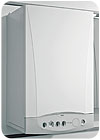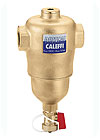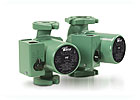
With housing starts down this year, about 27% - the lowest since 1991 - the hydronic heating market has seen a switch to renovation and retrofitting. According to Runtal North America’s VP Sales and Marketing - residential and towel radiator divisions, Owen Kantor, “In this renovation market, panel radiators lend themselves to ease of installation in comparison to other hydronic products such as infloor heating. Fin-tube products are easily replaced with panel radiators, affording the homeowner a radiant product.” Dan Chiles, VP marketing of Watts Radiant, agrees, explaining, “We’re seeing a strong new market in urban renewal - converting old inner city buildings into useful spaces for both living and commercial. Hydronic offers more efficient solutions in smaller footprints and it’s a natural for rehab.”
As commercial opportunities arise, more manufacturers like Caleffi North America are seeing their product mix shift to larger-dollar items. Buyers are becoming more interested in energy savings and zoning flexibility, and hydronic products offer these fuel options.
Taking full advantage of condensing technology is also gaining in popularity. Specifiers are asking for integrated hydronic solutions, such as mechanical designs that combine radiant, water source heat pumps, rainwater collection, solar, waste heat recovery and snowmelting, notes Chiles of Watts Radiant. “This trend will accelerate as manufacturers and installers get comfortable with these combined technologies,” he says.
Due to increased global awareness of the need for fuel consumption efficiencies and alternative fuel sources, hydronic heating is seeing green. According to Marathon International President Mike Thomas, the exclusive North American distributor of Baxi products, “The industry and our customers are gaining a better understanding of the value of full modulation and system controls. Environmentally friendly heating technologies, such as modulating, condensing boilers, promise to dramatically lower emissions of CO and NOx, and reduce fuel consumption vs. traditional boilers and furnaces.”
Interest in solar hydronic heating continued to accelerate this year. Mark Olsen, Caleffi’s general manager, notes that interest is coming from places like the Midwest and East, not only perennially sunny regions of the U.S.
As for the market’s future, “Sustainability will become the over-riding theme for hydronic heating providers,” says Thomas, adding that producing lower emissions and achieving higher efficiencies are essential. Watts Radiant predicts a similar outlook. “U.S. cities [will] try to make better use of ‘waste’ heat from power generation or industrial processes. ‘New Urbanism’ communities will be planned with all-hydronic heat. Fortunately, the practical implementation of these ideas is on full display in many countries in northern Europe,” says Chiles.

Featured Products Gallery
Baxi’s Luna HT 1.100 modulating, condensing wall-hung boiler generates up to 348,000 Btuh and is ideal for customer home and light commercial applications.




